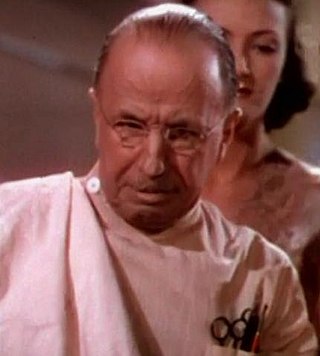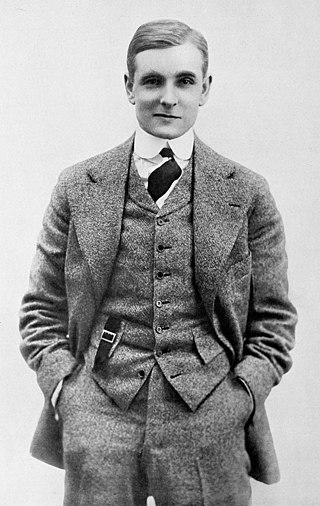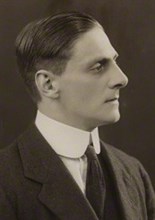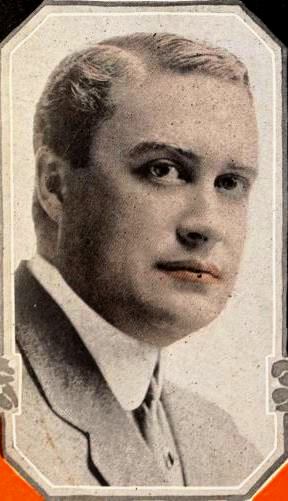Related Research Articles

Stuart Erwin was an American actor of stage, film, and television.

Orry-Kelly was the professional name of Orry George Kelly, an Australian-American Hollywood costume designer. Until being overtaken by Catherine Martin in 2014, he was the most prolific Australian-born Oscar winner, having won three Academy Awards for Best Costume Design.

Arthur Hoyt was an American film character actor who appeared in more than 275 films in his 34-year film career, about a third of them silent films.

Olivia Joyce Compton was an American actress.

Creighton Hale was an Irish-American theatre, film, and television actor whose career extended more than a half-century, from the early 1900s to the end of the 1950s.

William Edward Vickers (1889–1965) was an English mystery writer better known under his pen name Roy Vickers, but used also the pseudonyms Roy C. Vickers, David Durham, Sefton Kyle, and John Spencer. He is the author of over 60 crime novels and 80 short stories. Vickers is now remembered mostly for his attribution to Scotland Yard of a Department of Dead Ends, specialized in solving old, sometimes long-forgotten cases, mostly by chance encounters of odd bits of strange and apparently disconnected evidence.

John Farrell MacDonald was an American character actor and director. He played supporting roles and occasional leads. He appeared in over 325 films over a four-decade career from 1911 to 1951, and directed forty-four silent films from 1912 to 1917.

Mario Camerini was an Italian film director and screenwriter.

Elisabeth Risdon was an English film actress. She appeared in more than 140 films from 1913 to 1952. A beauty in her youth, she usually played in society parts. In later years in films she switched to playing character parts.

Richard Tucker was an American actor. Tucker was born in Brooklyn, New York. Appearing in more than 260 films between 1911 and 1940, he was the first official member of the Screen Actors Guild (SAG) and a founding member of SAG's Board of Directors. Tucker died in Woodland Hills, Los Angeles from a heart attack. He is interred at Forest Lawn Memorial Park, in an unmarked niche in Great Mausoleum, Columbarium of Faith.

Robert O'Connor, also known professionally as Robert Emmett O'Connor and Robert E. O'Connor was an Irish-American actor. He had a lengthy career as a stage actor on Broadway and in vaudeville from 1905-1931; using the stage name Robert O'Connor in both musicals and plays. After transitioning to film, he also used the names Robert Emmett O'Connor or Robert E. O'Connor for his screen credits. He appeared in more than 200 films between 1919 and 1950; specializing in portraying policemen. He is probably best remembered as the warmhearted bootlegger Paddy Ryan in The Public Enemy (1931) and as Detective Sergeant Henderson pursuing the Marx Brothers in A Night at the Opera (1935). He also appeared as Jonesy in Billy Wilder's 1950 film Sunset Boulevard. He also made an appearance at the very beginning and very end of the Metro-Goldwyn-Mayer cartoon short Who Killed Who? (1943).

Astrid Allwyn was an American stage and film actress.

Selmer Adolf Jackson was an American stage film and television actor. He appeared in nearly 400 films between 1921 and 1963. His name was sometimes spelled Selmar Jackson.
Irene Swatridge, née Irene Maude Mossop was a British writer of over 175 children's and romance novels.

Hale Rice Hamilton was an American actor.
Norman G. Arnold was a British art director who designed the sets for over a hundred and twenty films.

Sarah Edwards was a Welsh-born American film and stage actress. She often played dowagers or spinsters in numerous Hollywood movies of the 1930s and 1940s, mostly in minor roles.

Harry Fischbeck (1879–1968) was a German-born cinematographer who emigrated to the United States where he worked in the American film industry. He was employed by a variety of different studios during his career including Universal, United Artists and Warner Brothers, but primarily for Paramount Pictures. One of his first credits was for the historical The Lincoln Cycle films directed by John M. Stahl.
Ben Lewis (1894–1970) was an American film editor who worked in Hollywood for several decades. He was employed by MGM for many years, beginning his career with them in the silent era. An early credit was for Quality Street (1927) starring Marion Davies.
References
- ↑ "Trove". trove.nla.gov.au.
- 1 2 "Dec. 20, 1947: Pulp Author Rob Eden Dies | Author of 'Short Skirts: A Story of Modern Youth'". December 20, 2018.
- ↑ "Rob Eden". www.librarything.com.
- ↑ "In Love with a T-Man". The Salt Lake Tribune. 1937-12-05. p. 64. Retrieved 2021-03-13.
- ↑ "Goddess in a Jungle". Nashville Banner. 1935-09-22. p. 29. Retrieved 2021-03-13.
- ↑ "Light Romance: Honeymoon Delayed". Fort Worth Star-Telegram. 1937-05-02. p. 44. Retrieved 2021-03-13.